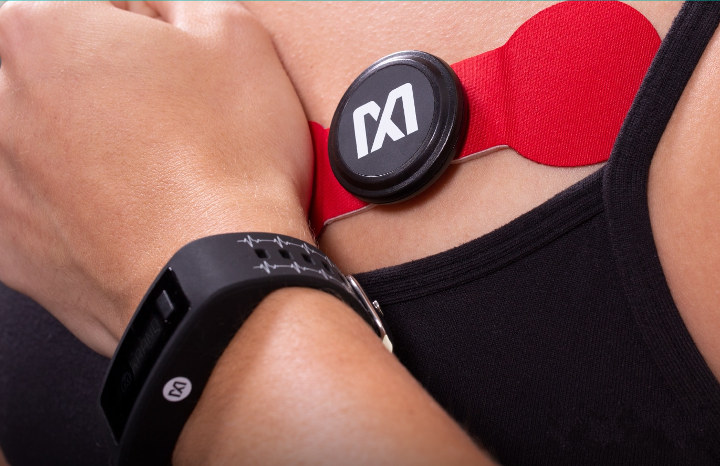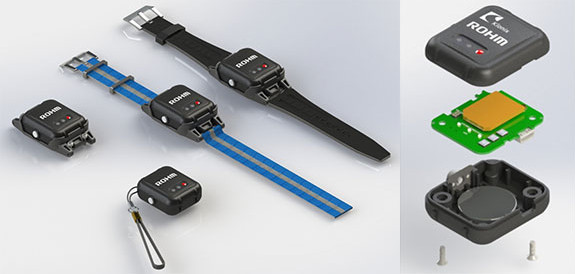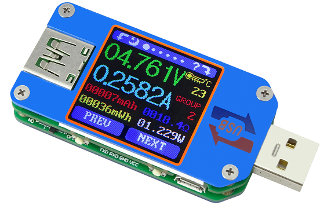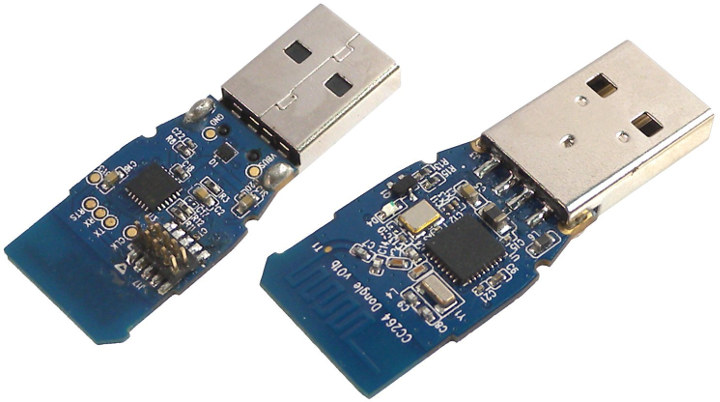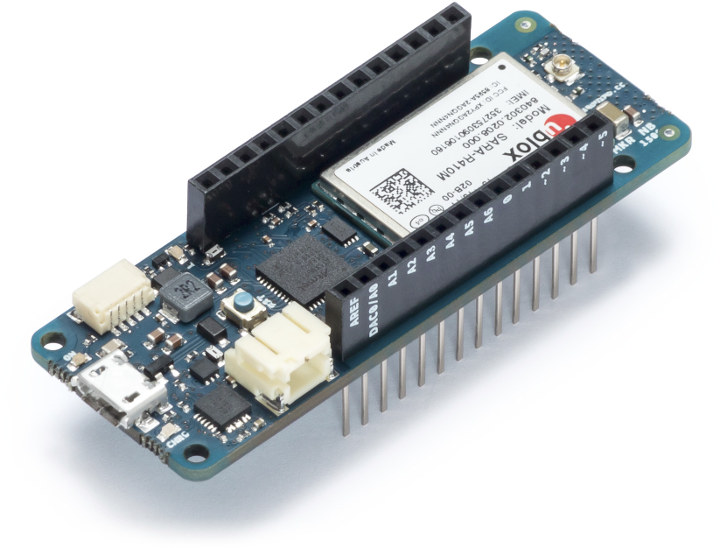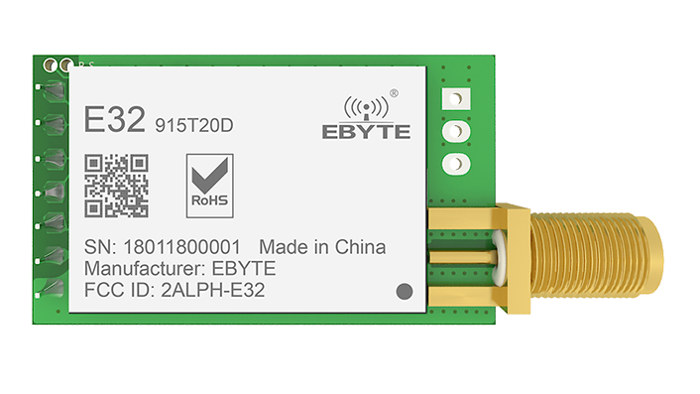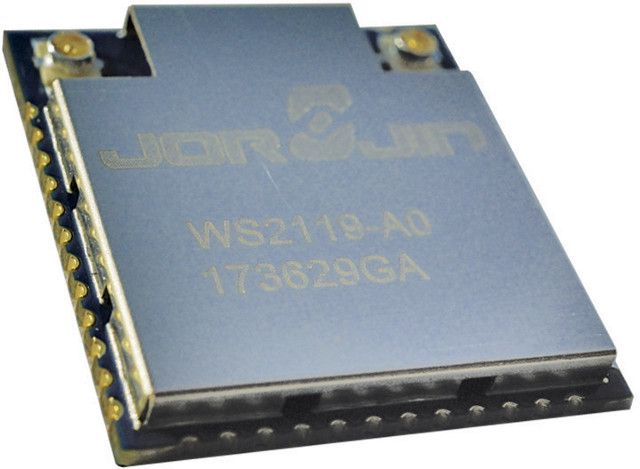Maxim Integrated has recently announced two wearable development kits for fitness / health tracking: MAX-HEALTH-BAND watch for vital signs MAX-ECG-MONITOR with a chest strap for clinical-grade electrocardiograph (ECG) and heart rate. MAX-HEALTH-BAND Development Kit The MAX-HEALTH-BAND wrist-worn heart-rate and activity monitor features the company’s MAX86140 optical pulse-oximeter/heart-rate sensor, MAX20303 wearable power-management solution, and Maxim’s motion-compensated algorithms. The watch sends raw PPG and accelerometer data via Bluetooth to a smartphone app, and also monitors steps, activity, heart rate and interbeat intervals for heart-rate variability measurements. Battery life is around 7 days on a single charge. The kit also includes a USB charging cable, and instructions to download the Android-based application. The evaluation platform can be used for the development of fitness and wellness trackers, health monitoring trackers, or as a experimentation platform for new use cases and algorithms. In addition to raw PPG and accelerometer data, the MAX-HEALTH-BAND monitors steps, activity, […]
RoKi Sensor Node Bluetooth 5 Devkit is Equipped with Multiple Sensors
ROHM and Kionix have just introduced the RoKi Sensor Node, part of the new RoKi IoT Platform. The sensor node is based on Nordic Semiconductor’s nRF52840 Bluetooth 5 LE System-on-Chip (SoC), and integrates multiple sensors from Kionix and ROHM. RoKi Sensor Node specifications: MCU – Nordic Semi nRF52840 Bluetooth 5 Arm Cortex M4F processor @ 64 Mhz with 1 MB flash, 256kB RAM Sensors Built-in 3-axis accelerometer Combination 3-axis accelerometer + 3-axis magnetometer Combination 3-axis accelerometer + 3-axis gyroscope 3-axis magnetometer Barometer Available with expansion connectors Optical heart rate sensor Ambient light sensor RGB color sensor Magnetic hall effect sensor etc Misc – Programmable RGB LED Power Supply – Rechargeable Li-Polymer battery, replaceable coin cell batteries, or via Micro USB. Battery life – Active time is about 8 hours of typical usage, and an estimated standby time of 200 hours. Dimensions – 42x67x22mm The sensor node comes with a mounting […]
UM25C is a Better USB Power Meter with built-in Display, Bluetooth, and Android & Windows Apps
Products such as USB Charger Doctor are good way to test your USB chargers or cables, as well as checking the power consumption of USB powered development boards. You just plug them into a USB port, and connect the load, and you’ll see the real-time voltage and current shown on an LED display. Those do the job, but I’ve just been made aware of UM25C USB meter tester that improves a lot on the concept with a dot matrix display capable of showing charts, and Bluetooth connectivity to send the data to Android or Windows devices. UM25C specifications: Display 1.44″ color LCD display 0-5 brightness setting Auto screen off time – 0 to 9 minutes Refresh rate – 2Hz Measurement Range & Accuracy Voltage – 4-24.000V ±0.5‰ + 2digits Current – 0-5.0000A ±1‰ + 4 digits Capacity – 0-99999mAh Energy accumulation – 0-99999mWh Load impedance – 0.8Ω-9999.9Ω Time range – […]
MakerSpot CC2640 is a $20 Bluetooth 5 LE USB Dongle
Bluetooth 5 was announced in May 2016 with four times the range, twice the speed of Bluetooth 4.0. Since then SoCs, development boards, and smartphones have been announced with Bluetooth 5, but so far I had not seen any Bluetooth 5 USB dongle to add the new Bluetooth version to existing computer or boards. While I’ve not been able to find a consumer grade Bluetooth 5 USB dongle yet, today I found out something close it to with MakerSport CC2640 USB dongle / board based on TI CC2640 chip. GT-Tronics CC264BPA-UDOG (actual name) USB dongle specifications: MCU – Texas Instrument CC2640R2F Arm Cortex-M3 SimpleLink Wireless SoC with Bluetooth 5.0 Connectivity – Bluetooth 5 Low Energy BLE including built-in antenna; backward compatible with BLE 4.0, 4.1, 4.2 Silabs CP2110 HID to UART bridging device Debugging – 10-pins JTAG connector for CC2640 debugging and firmware flashing The dongle is enumerated as generic HID […]
Arduino Introduces Two New IoT Boards – MKR WiFi 1010 (ESP32) and MKR NB 1500 (NB-IoT + eMTC)
Arduino introduced its MKR family of breadboard compatible maker boards with MKR1000 featuring an Atmel SAMD21 microcontroller combined with a Microchip WINC1500 WiFi module. The board was followed by MRKZero without wireless connectivity, then MKRFOX1200 Sigfox board, and finally MKR WAN 1300 & MKR GSM 1400 boards at the end of 2017 with LoRaWAN and 3.75G cellular connectivity. The company has now launched two new boards: Espressif ESP32 based MKR WiFi 1010 with WiFi and Bluetooth, and MKR NB 1500 equipped with an NB-IoT & LTE CAT M1 module. Arduino MKR WiFi 1010 MKR WIFI 1010 is an evolution of the MKR1000 board, and is equipped with a U-Blox ESP32 module. Preliminary specifications: MCU – Microchip SAMD21 Cortex-M0+ MCU @ 48 MHz with 32KB SRAM, 256 KB flash memory Wireless Connectivity – 2.4 GHz 802.11 b/g/n WiFi and Bluetooth 4.2 LE via U-blox NINA-W10 Series module based on ESP32 processor. […]
Ebyte Offers Low Cost Wireless Modules for LoRa, Zigbee, NB-IoT, Bluetooth, and More
Chengdu Ebyte Electronic Technology Ltd (or just Ebyte for short) is a company based in Western China that design and manufacturer low cost wireless modules for LoRa, WiFi, Bluetooth, Zigbee, NB-IoT & GPRS cellular connectivity, many of which appear to be FCC certified. The list of modules is way too long, so I’ll just have a look at two products from the company: Ebyte E32-915T20D LoRa 915 MHz module and Ebyte ME3612 NB-IoT wireless module. Ebyte E32-915T20D LoRa 915 MHz module Specifications: Connectivity Semtech SX1276 LoRa 900~931MHz (default: 915 MHz), 32 channels Range – up to 3 km with 20 dBm power, 5 dBi antenna Data rate – 2.4 kbps (default), configurable to 0.3, 1.2, 2.4, 4.8, 9.6, 19.2 kbps Rx Sensitivity – -138dbm at 0.3kbps Expansion – 7-pin header 2.54mm pitch with UART, USART host interface Power Supply – 2.1 to 5.5V DC Power Consumption – Standby: 2.0 uA; Tx: 120 mA […]
Jorjin WS2118/WS2119 is a Sigfox & Bluetooth LE Module Based on STMicro BlueNRG-1 & S2-LP Chips
Jorjin WS211X is a family of certified dual radio modules combining Sigfox wireless technology thanks to STMicro BlueNRG-1 BLE System-on-Chip (SoC) and Bluetooth Low Energy (BLE) using STMicro S2-LP sub-1GHz RF transceiver. Two models are currently available: WS2118-00 certified for Sigfox regions RCZ1 (Europe, Middle East, South Africa) and RCZ3 (Japan), and WS2119-A0 for regions RCZ2 (USA, Mexico, Brazil) and RCZ4 (Australia, New Zealand, Taiwan, Hong Kong, Singapore, Argentina). Jorjin’s WS211x specifications: Connectivity Bluetooth LE STMicro BlueNRG-1 Arm Cortex M0 @ 16 MHz with 160 kB flash, 24 kB RAM with retention Up to +8dBm BLE RF output power Sigfox STMicro S2-LP sub-1GHz transceiver WS2118-A0 – Up to +16 dBm sub-1GHz RF output power WS2119-A0 – Up to +27dBm sub-1GHz RF output power Receiver sensitivity – Up to -88dBm (BLE) and -130dBm (Sub-1GHz). I/Os – 38-pins package. Security – STSAFE-A1SX for SIGFOX secure element Power Supply – 2.0 to 3.6V Dimension […]
RAK8211-NB iTracker Battery / Solar Powered Module Comes with NB-IoT & Bluetooth 5 Connectivity, GPS, and 5 Sensors
Rak Wireless has recently launched a new products called RAK8211-NB iTracker based on a Quectel BC95-G NB-IoT module, Nordic Semi nRF52832 Bluetooth 5 chip, and Quectel L70-R GNSS module. The asset tracker module also comes with 5 different sensors to monitor motion and environmental data, and can optionally be powered directly by a solar panel.RAK8211-NB iTracker specifications: Connectivity NB-IoT via Quectel BC95-G (Global) wireless communication module + SIM card socket Bluetooth 5 via Nordic Semi nRF52832 Arm Cortex-M4F micro-controller (Arduino compatible) GPS/GLONASS via Quectel L70 GNSS module Sensors LIS3DH 3-axis “nano” accelerometer LIS2MDL 3-axis digital magnetic sensor. Tilt sensor BME280 pressure, humidity and temperature sensor OPT3001 intensity of light sensor Expansion – 3x headers with SWD, 2x sensor out + tilt out (also usable as GPIO and analog inputs), 3.3V, GND, and reset Power Supply – 3.5V to 18V via solar panel (P2) or battery (P3) Dimensions – 43mm x […]


